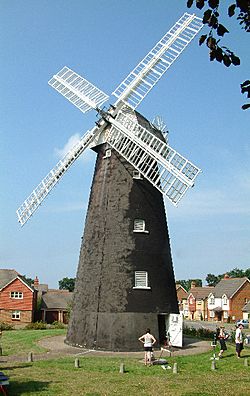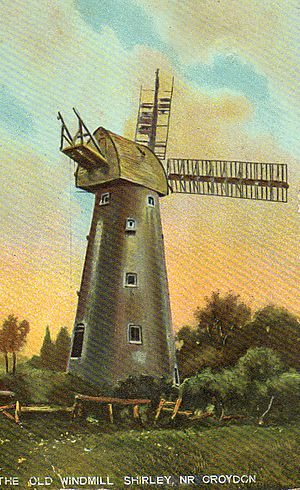Shirley Windmill facts for kids
Quick facts for kids Shirley Windmill |
|
|---|---|

Shirley Windmill
|
|
| Origin | |
| Mill name | Shirley Windmill |
| Mill location | Shirley, Croydon |
| Grid reference | TQ 355 652 |
| Coordinates | 51°22′12″N 0°03′18″W / 51.370°N 0.055°W |
| Operator(s) | Friends of Shirley Windmill |
| Year built | 1854 |
| Information | |
| Purpose | Corn mill |
| Type | Tower mill |
| Storeys | Five storeys |
| No. of sails | Four sails |
| Type of sails | Patent sails |
| Windshaft | cast iron |
| Winding | Fantail |
| Fantail blades | Eight blades |
| Auxiliary power | Engine |
| No. of pairs of millstones | Two pairs |
The Shirley Windmill is a really cool old building in Shirley, Croydon, England. It's a special type of windmill called a tower mill. This windmill is so important that it's a "Grade II listed building," which means it's protected because of its history and unique design. Today, it's been fixed up and can even work again!
Contents
The Story of Shirley Windmill
How the Mill Began
Shirley Windmill was built in 1854 by a man named Richard Alwen. It replaced an older windmill, a "post mill," that had burned down. The first post mill was built in 1809 by Richard Alwen Sr. When he passed away in 1846, his son, Richard Alwen, took over. Sadly, the post mill was destroyed by fire in October 1854.
People think parts of the new tower mill might have come from another windmill in Stratford. There's a beam inside the mill with the date 1740 on it. This suggests that some materials were reused from an even older building. Building the Shirley Windmill cost about £2,000, which was a lot of money back then!
Challenges and Changes
Richard Alwen passed away in 1884. After him, his grandson, Thomas Dives, took charge of the mill. By 1892, the mill was no longer used for grinding flour for people. It was only used to grind food for animals. Soon after, it was completely stopped because it wasn't making enough money.
The windmill faced some tough times. It was hit by lightning in 1899 and again in April 1906. The second lightning strike even set one of its sails on fire! Luckily, the local firefighters were able to save the mill.
In 1927, the mill was repaired. Then, in 1935, a strong wind blew off one of its sails. More repairs were done, and new parts were added. New sails were also put on by a special mill builder named Thomas Hunt. After all this work, the windmill was almost ready to work again.
Protecting the Mill
In 1951, Shirley Windmill was officially listed as a protected building. It was probably the last big windmill built in the area that was once Surrey. In 1952, the local council, Croydon Corporation, bought the mill and the land around it.
There was a time when the mill was almost torn down to make way for a new school, John Ruskin School. But because it was a protected building and many people cared about it, the mill was saved. Experts checked the mill and found it was in good shape. They suggested opening up a doorway on the first floor to help air move around and prevent wood from rotting.
Fun and Restoration
On April 1, 1971, some students from the school played an April Fool's Day joke. They put an advertisement in The Times newspaper saying the mill was for sale! The headmaster received four phone calls because of the prank.
Later, the school moved to a new place, and the old school buildings were taken down. In 1996, good news arrived! The London Borough of Croydon received a grant of £218,100 from the Heritage Lottery Fund. This money was to help turn the windmill into a museum. In 2004, the Croydon Council agreed to pay for outside repairs, which started the next spring.
In October 2008, there was a new problem: rose-ringed parakeets were damaging the mill's sails! These birds had also damaged a nearby church spire. The sails were repaired by special mill builders, costing £45,000. All the restoration work was finished in May 2010.
What the Mill Looks Like
Shirley Windmill is a tall, five-story building made of brick. It has four large "Patent sails" that catch the wind. These sails are attached to a strong cast-iron shaft. A special "fantail" helps turn the cap of the mill so the sails always face the wind.
The base of the mill is about 21 feet (6.4 meters) wide, and it gets narrower towards the top, where it's about 11 feet (3.3 meters) wide. The whole mill stands about 55 feet (16.7 meters) tall to the very top of its cap.
Inside, there's a big iron "Brake Wheel" that is about 9 feet 3 inches (2.8 meters) across. It has 172 teeth! This wheel turns another iron wheel called a "Wallower." A long, strong iron shaft goes down through the mill. This shaft has a special "dog clutch" that lets the mill be powered by an engine if there's no wind. The "Great Spur Wheel" is made of iron with wooden teeth. It used to power two pairs of large millstones that ground the corn.
Millers Who Worked Here
These are some of the people who operated the Shirley Windmill:
- Richard Alwen Sr (1809–1846) - He ran the first post mill.
- Richard Alwen Jr (1846–1884) - He ran both the post mill and the tower mill.
- Thomas Dives (1884–)
- Alfred Rayson (–1892)
Visiting the Windmill
You can visit Shirley Windmill! It's open to the public on the first Sunday of each month from June to October, usually from 1 PM to 5 PM. The "Friends of Shirley Windmill" group organizes tours. It's also open on special days like Heritage Day and National Mills Day. If you want to visit on a weekday, you can arrange a tour in advance.


